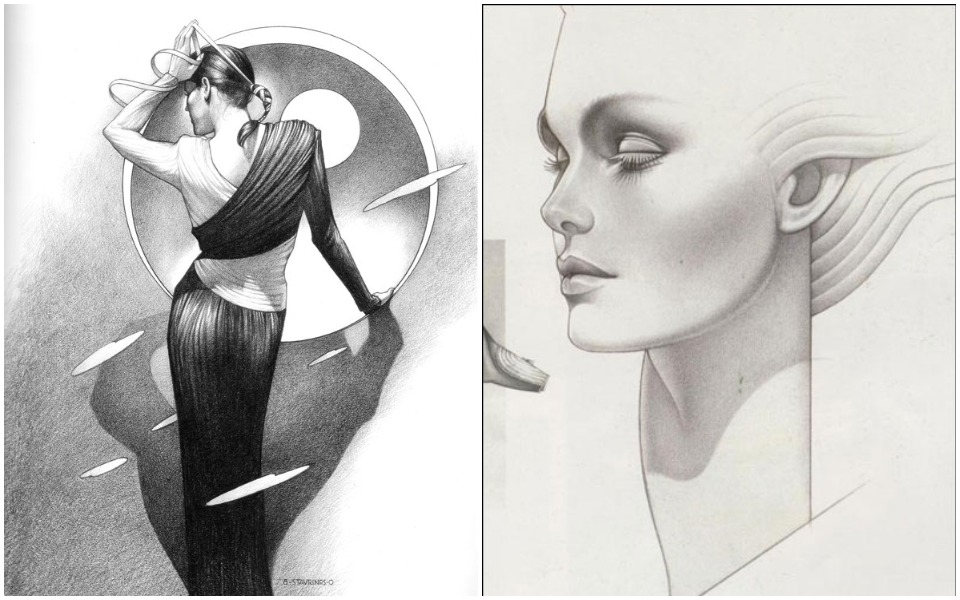The Greek American who captured the zeitgeist in fashion illustration

Blogger Gina Moyer writes that fashion illustration has the “dexterity to freeze a moment in history through the lenses of artistic style, attitudes reflective of the time period, and the latest trends in fashion…” George Stavrinos (1948-90) did much more than that. With his extraordinary craftsmanship and artistic genius, his work ventures into the fine arts, knocking fashion illustration right out of the park.
Bradford Hamann, assistant professor of graphic design at Shepherd University, writes that Stavrinos revolutionized fashion illustration, proving that it could be “imbued with dramatic content, it could be monumental in feel, and it could stand as ‘Art’ in the truest sense of the word.”
It’s been said that Stavrinos’ art belongs to Superrealism, a movement of the late 1960s and early 70s in which art approaches the realism of photography. According to Hamann, it involved “such painstaking detail, that he ultimately came to use an F lead mechanical pencil almost exclusively.” His process began with hundreds of photographs of his model in various poses and at various focal lengths using a Polaroid SX-70. He would then create an environment around the model that included a variety of shapes and materials, such as pottery, fans, lights and various geometric designs. His niece Cynthia Morakis Pursley was privileged to draw with her uncle, as well as watch him work. She especially recalls the time he placed his model in his bathtub because he liked the tile as background. Whatever his process, Stavrinos always created “an arresting new look that set the pace for his contemporaries and still continues to be an influence.” Judging by his work, it is clear that he thought of illustration as true art and did his utmost to render it as such. His fine details suggest that he did not underestimate his viewers and valued their appreciation of his work.
Stavrinos was born in Somerville, Massachusetts, to Greek immigrants, who carved a good life for themselves and their children. His father ran the Sunrise Diner in South Boston, and his mother, an excellent seamstress, assembled soldiers’ uniforms during WWII. Their history was a painful one. To escape persecution and likely death after repeated pogroms by Turkish irregulars and the Turkish army, they fled their homes on the Aegean coast of Asia Minor where Greeks had lived for thousands of years. His father, Theophilos John Stavrinos, born in the town of Reis Dere near Smyrna, arrived in the US in 1916 at the age of 16. George’s mother, Asemo Davazoglou, born in Alatsata, also near Smyrna, took her ailing sister’s place on the ship to be with her brothers, who had already settled in the Boston area. Both parents survived the 1914 pogrom and massacre in the region. Asemo’s family fled to the Greek island of Chios, with some members ultimately coming to America, others settling in Chios, and others still moving to the island of Crete. It was in 1922, when millions of Greeks and Armenians in the region were slaughtered, that the family finally accepted the loss of their homeland, carrying this sense of loss for the rest of their lives.
Their children grew up typically Greek American. Family life revolved around the Greek Orthodox Church of the Dormition of the Virgin Mary in Somerville, where George served as an altar boy and attended Greek language classes, becoming fluent in Greek. His murals for school plays and pageants still adorn the church walls.
Being the youngest of seven children – five sisters and two brothers – with a 21-year difference from his oldest sister, George did not suffer from lack of attention. He clearly was, and still is, adored by siblings, nephews and nieces, who miss him and hope to foster appreciation for his work. Surrounded by his art in their homes, George continues to be an important part of their lives.
Theo Mitropoulos, George’s nephew, remembers him as a devoted artist and a humorous, quick-witted, fun-loving guy, with impeccable taste in movies and restaurants. “My uncle produced quite a volume of work on a weekly basis. But he still had time to throw some great parties and enjoy the New York club scene.”
George’s deftness and passion for drawing became evident as soon as he could wield a pencil and a brush. Recognizing both his skillfulness and his deep desire to draw, his extensive family indulged him and encouraged him to pursue his talent. Under scholarship from the Tiffany Foundation of New York, he studied graphics at the Rhode Island School of Design, distinguishing himself as a star student. Accepted into an honors program, he also spent a semester in Rome studying architecture and fashion design. From there he traveled to Crete, meeting the side of the family that had settled there, delving into studying and drawing the architectural elements of the Minoan Palace at Knossos. It was here that family became more important for George, who frequently counseled his nieces and nephews on the value of family.
After graduation, George spent time in Boston and Philadelphia, taking on a variety of assignments, finally moving to New York in 1973, creating illustrations for the travel section of The New York Times and its Sunday Magazine. In March 1974, his first fashion spread appeared in the Times. Freelancing with Pushpin Studios, he took on high-end clients such as Bonwit Teller, Gentlemen’s Quarterly, and Keio Stores in Japan. In 1977, he was hired by Barneys, a men’s fashion store in the midst of abandoning its discounted brands image and developing into a luxury store.
But as Hamann writes, it was at Bergdorf Goodman that Stavrinos “reached the fashion world’s stratosphere…” creating a compelling and dynamic graphic and brand identity for the iconic luxury retailer that specialized in women’s fashion. In 1984, he created a series of character drawings for the New York City Opera’s promotional campaign. This was to be the beginning of a new era in theater for George, as his brother-in-law John Morakis confirms; a new phase cut short by his illness and untimely death at the young age of 42 due to complications from AIDS.
In addition to fashion, Stavrinos also drew book covers, including for a mystery series by Gore Vidal, published under an alias. He also contributed to LGBT art. His illustrations were published in numerous gay magazines, including Christopher Street, Blueboy, and Gay Source: A Catalog for Men. He also illustrated the covers of gay poetry and prose books, including Paul Monette’s novel “Taking Care of Mrs Carroll.”
Despite his brief life, George created an astonishing amount of work. His talent and artistic versatility, along with a strong work ethic, allowed for a prolific pace, a variety of media, and a broad range of clients, without compromising the quality of his work or his unique artistic style. His sister Lydia remembers how well he worked under pressure to meet deadlines. Always aiming high, Stavrinos was inspired by the best, including Norman Rockwell, Maxfield Parrish and J.C. Leyendecker, three of the most prominent names in American illustration.
In 2007, his talent was commemorated posthumously when he was elected to the Society of Illustrators Hall of Fame. In 2013, the Museum of American Illustration showcased his work in “The Vision of George Stavrinos,” an exhibition of over 100 illustrations highlighting his innate artistic ability and brilliant career.
The publishing world has not extended Stavrinos the same kind of recognition, however. This absence of studies and publications may be due to the fact that while George’s works are strewn in various collections, no systematic or extensive public archives are readily available for students, faculty and independent researchers to study.
Thankfully, the published thesis of Bradford Hamann, the source for much of the information in this article, provides great insight into Stavrinos’ life and work. In addition, countless testimonials on the web by fellow illustrators, friends and students pay tribute to George’s spirit and talent, keeping his memory alive.
It is thus no surprise that 30 years after his death, George Stavrinos continues to be heard, to influence and inspire, while adored and missed not only by his biological family, but by a huge family of admirers and fellow illustrators who still consider him one of the best.
Connie Mourtoupalas is an exhibitions curator and former president of the National Hellenic Museum in Chicago.





